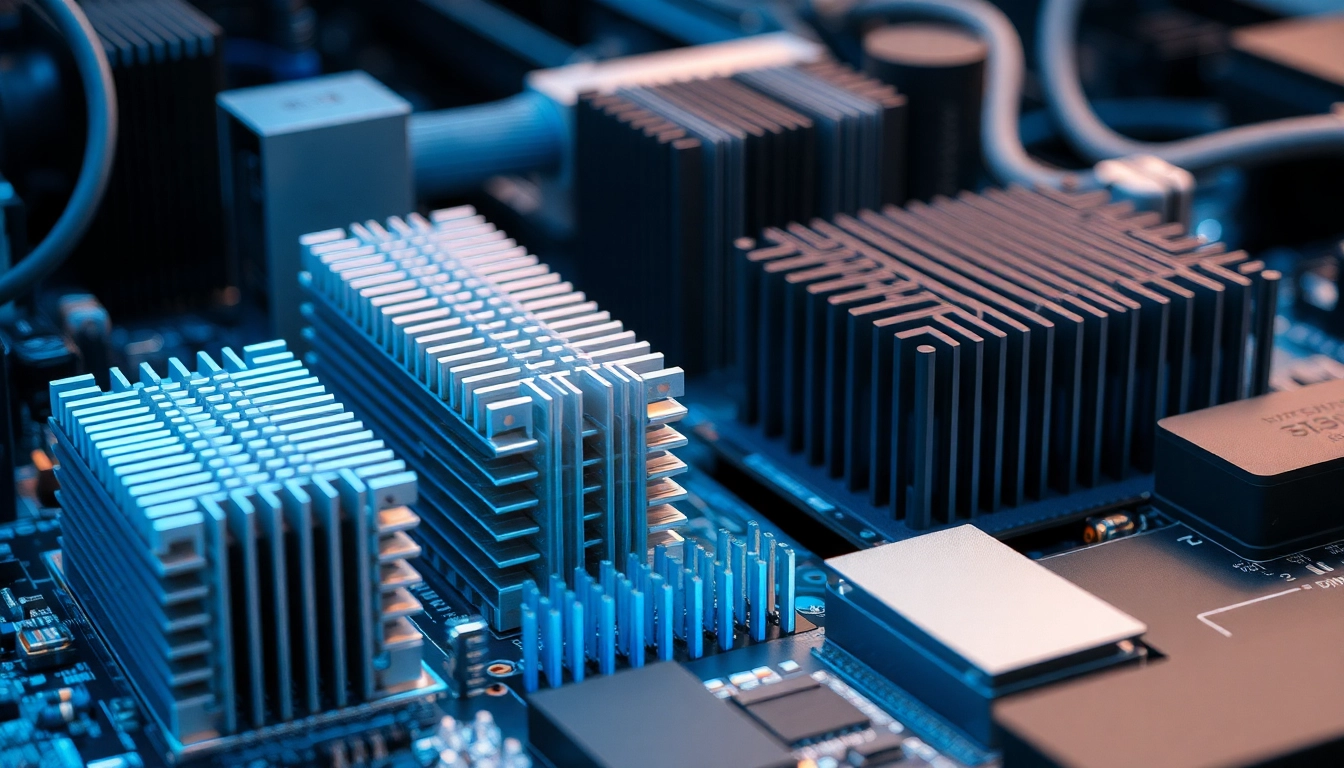Understanding Thermal Management Materials
What Are Thermal Management Materials?
Thermal management materials are essential components in the design and manufacturing of electronic devices, playing a critical role in maintaining optimal operating temperatures by effectively dissipating and managing heat. These materials can take various forms, including thermal interface materials (TIMs), gap fillers, phase change materials, and more. Their primary function is to facilitate heat transfer away from sensitive components, thereby enhancing the performance and reliability of electronic devices.
In electronics, excessive heat can lead to reduced efficiency, failures, and even catastrophic malfunctions. For this reason, utilizing high-quality thermal management materials is crucial for designers and engineers. These materials ensure that heat generated by components is effectively transferred away, maintaining a safe temperature range and prolonging the device’s lifespan.
The Importance of Heat Dissipation
Heat dissipation is vital in electronic applications, especially in high-performance areas like computing, automotive, and aerospace industries. When electrical currents flow through a conductor, they generate heat due to resistance. If this heat is not managed correctly, it can accumulate, leading to overheating. This not only degrades performance but can also permanently damage components.
The consequences of inadequate heat management can include:
- Reduced electronic efficiency
- Component failure which can lead to costly repairs
- Safety hazards including fire risks
- Reduced device lifespan
Hence, a robust thermal management strategy is essential, incorporating advanced materials that can efficiently perform under varying stress and temperatures.
Types of Thermal Management Materials
Understanding the different types of thermal management materials can help engineers select the most appropriate solutions for specific applications. The common types include:
- Thermal Interface Materials (TIMs): These materials fill the microscopic gaps between heat-generating components and heat sinks, drastically improving heat transfer efficiency.
- Gap Fillers: Designed for applications with imperfect surfaces, gap fillers conform to irregular shapes, ensuring a good thermal interface.
- Phase Change Materials (PCMs): These materials absorb and release heat during phase transitions, helping to manage temperature fluctuations effectively.
- Thermal Greases and Adhesives: These are used to bond components while providing thermal conductivity, filling in gaps that could hinder heat transfer.
- Thermal Pads: Often made of silicone or other polymers, they provide a simple solution for thermal management in various applications.
Applications of Thermal Management Materials
Electronics Cooling Solutions
In the electronics sector, thermal management materials are crucial for cooling solutions, especially in high-performance computing, gaming, and telecommunications. They are applied in CPUs, GPUs, power supplies, and other critical components that generate significant heat. By using materials such as TIMs and thermal pads, manufacturers can ensure that devices operate within safe temperature thresholds.
For example, innovative cooling designs using gap fillers enable better thermal distribution in multi-chip systems, improving overall device performance. Additionally, advancements in materials allow for thinner and more efficient profiles, which are particularly beneficial in compact electronics like smartphones and laptops.
Automotive and Aerospace Uses
In the automotive industry, thermal management materials are instrumental in electric vehicles (EVs) and internal combustion engines. They help manage heat in batteries, power electronics, and electric motors. The increasing demand for electrification has led to the development of specialized materials that can withstand the demanding thermal cycles in automotive applications.
Aerospace applications also benefit significantly from advanced thermal management. High-altitude environments expose materials to extreme temperatures, requiring reliable heat management solutions to ensure the functionality and longevity of avionics and other equipment.
Innovations in Thermal Interface Materials
Recent advancements in thermal interface materials are continuously pushing the envelope of thermal management capabilities. Innovations such as liquid-phase TIMs and high-conductivity graphene composites are revolutionizing the industry. These materials not only improve thermal conductivity but also provide flexibility and mechanical strength, essential for modern electronic components that encounter mechanical stress.
Moreover, developing materials with adaptive properties can lead to more dynamic thermal management systems, allowing real-time adjustments based on varying operational conditions.
Choosing the Right Thermal Management Materials
Factors to Consider
Selecting the appropriate thermal management materials requires consideration of several critical factors:
- Thermal Conductivity: The primary metric for evaluating thermal management materials. The higher the thermal conductivity, the more efficiently heat can be transferred.
- Operating Temperature Range: It’s essential to select materials that can withstand the specific temperature ranges anticipated in applications.
- Mechanical Properties: Considerations such as tensile strength, compressibility, and flexibility affect how well a material can be applied across varying designs.
- Thickness and Weight: In sectors such as automotive and aerospace, minimizing weight and thickness can be critical for overall design efficiency.
- Cost: Budget constraints always come into play when selecting materials. Balancing performance with cost is essential for project viability.
Performance Metrics and Testing
To ensure chosen thermal management materials meet performance expectations, thorough testing is crucial. Common testing methods include:
- Thermal Conductivity Tests: Methods such as the guarded hot plate and laser flash analysis help measure thermal conductivity accurately.
- Thermal Resistance Testing: Evaluating the thermal resistance between various interfaces can highlight potential inefficiencies in thermal pathways.
- Mechanical Testing: Assessing mechanical properties under various thermal and stress conditions ensures that materials can withstand operational environments.
Common Mistakes to Avoid
While navigating the selection and implementation of thermal management materials, some pitfalls can significantly impact the outcomes. Avoiding common mistakes can yield substantial benefits.
- Ignoring Manufacturer Specifications: Each material will have recommended uses; straying from these can lead to failure.
- Neglecting Environmental Conditions: Overlooking humidity, temperature variations, and physical stressors relevant to the application can result in inadequate material performance.
- Choosing Based Only on Cost: While budget is a consideration, selecting the cheapest option without factoring in performance can be costly in the long run.
Best Practices for Thermal Management
Installation Techniques for Optimal Efficiency
Proper installation of thermal management materials is crucial to maximize their effectiveness. Some best practices include:
- Surface Preparation: Ensuring that surfaces are clean and free from contaminants can significantly improve bonding and heat transfer efficiency.
- Correct Application Thickness: Following manufacturer guidelines for thickness ensures optimal performance. Too thin may lead to hotspots, while too thick could hinder performance.
- Uniform Pressure: Ensuring even pressure during installation can help eliminate air gaps that might hinder thermal conductivity.
Maintenance of Thermal Management Systems
To ensure long-lasting performance, regular maintenance of thermal management systems is necessary. This can include:
- Routine Inspections: Regularly check for signs of wear, degradation, or contamination of thermal materials.
- Material Replacement: If materials show signs of failure or inefficiency, prompt replacement can prevent system failures.
- Environmental Monitoring: Keeping track of the operational environment can help anticipate changes that might affect thermal management performance.
Trends and Future of Thermal Management
The future of thermal management materials looks promising, with ongoing research and development focused on enhancing performance, eco-friendliness, and multi-functional properties. Emerging trends include:
- Eco-Conscious Materials: The rise of biodegradable and environmentally friendly thermal management solutions reflects increasing environmental awareness across industries.
- Integration with Smart Technologies: Materials that interact with or adapt to operating conditions through sensors and feedback mechanisms are gaining interest.
- Miniaturization: As electronic devices continue to shrink, there will be a demand for thinner, lighter thermal management materials that do not compromise performance.
Case Studies and Success Stories
Effective Use in High-Performance Computers
High-performance computers face unique thermal challenges due to their dense packing of components. Companies leveraging advanced thermal management materials, such as liquid metal TIMs, have achieved remarkable temperature stability, significantly boosting performance. These innovations allow for higher clock speeds and more efficient power consumption while maintaining optimal operating conditions.
Improving Lifespan of Consumer Electronics
Several leaders in consumer electronics have successfully implemented thermal pads and phase change materials in their devices, resulting in extended lifespans. For example, a major smartphone manufacturer incorporating high-performance gap fillers has reported reduced thermal throttling and improved battery life, directly correlating enhanced user satisfaction with effective thermal management.
Real-World Applications in Industrial Settings
Industry-specific applications have also benefited from robust thermal management strategies. In manufacturing, utilizing thermal interface materials in robotic systems has demonstrated significantly reduced maintenance costs and improved operational uptime. Implementing a systematic approach towards thermal management not only enhances equipment reliability but also promotes productivity across industries.


